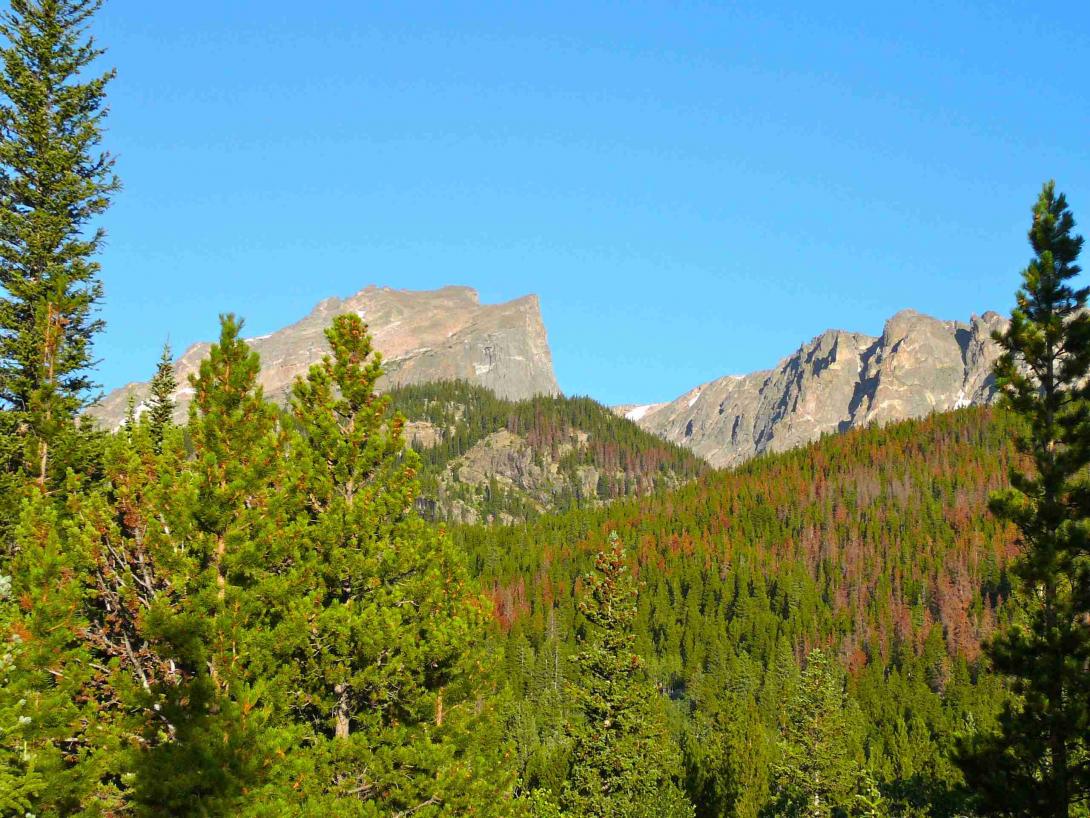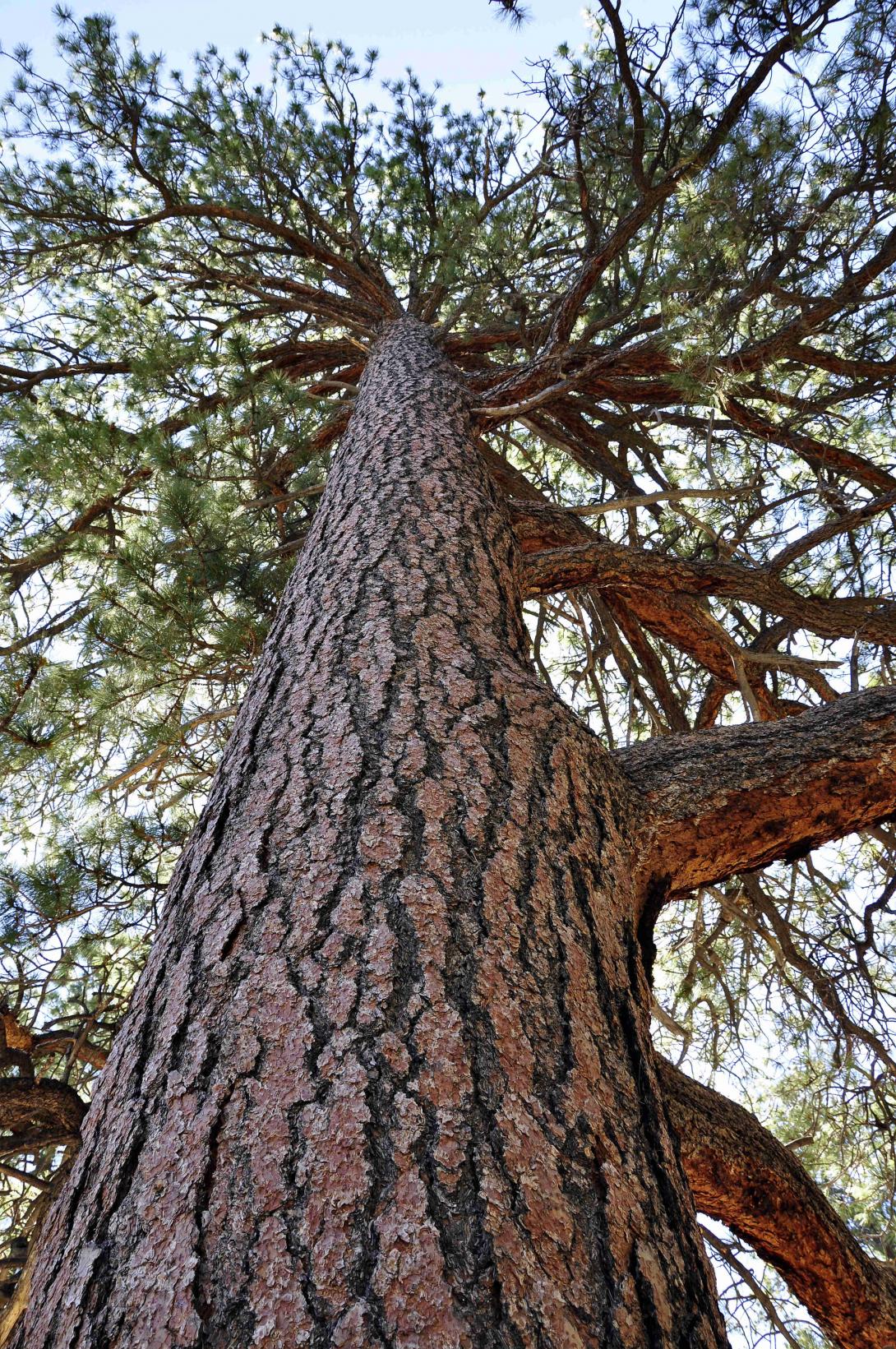Conifers
Full Article
From the tall, straight lodgepole pines in the high Rockies to the short, gnarled piñons that guard the state’s canyons and grasslands, coniferous trees dominate Colorado’s natural environments and hold together important ecosystems. Commonly referred to as pines or evergreens, coniferous trees are defined by needly leaves, seed-bearing cones, and thick, resinous sap that oozes from their trunks.
At first glance, many of Colorado’s conifers look similar, but the state’s most common needle-bearers represent several distinct species. These include the lodgepole pine (Pinus contorta), the ponderosa pine (Pinus ponderosa), the piñon pine (Pinus edulis), the limber pine (Pinus flexilis), several types of juniper (Juniperus), the Rocky Mountain Douglas-fir (Pseudotsuga menziesii var. glauca), the Engelmann spruce (Picea engelmannii), and the Colorado blue spruce (Picea pungens), the official state tree.
While all of these trees play important roles in their respective ecosystems, many face a range of natural and human threats today. These include bark beetle infestations, warming temperatures and droughts, fire suppression, and fire itself.
Lodgepole Pine
Lodgepole pines (Pinus contorta) are easily recognizable by their straight, relatively narrow trunks, which can reach upward of ninety feet. The name for these trees dates to 1859, the year of the Colorado Gold Rush, and probably refers to their use by Indigenous people. They live at higher elevations, generally between 6,000 and 11,000 feet, making them part of central Colorado’s breathtaking mountain scenery.
Lodgepoles have coevolved with human-caused wildfires, relying on blazes to open their cones after they drop to the ground. The two-inch cones can remain on the ground for many years waiting for fire; if the seedlings manage to sprout under an existing lodgepole canopy, they usually die, replaced by more shade-tolerant conifers such as spruces or Douglas-fir.
Lodgepoles are often presented as the poster trees for the mountain pine beetle epidemic that swept through Colorado’s pine forests in the 2000s. The trees have natural defenses against the beetle called terpenes, but lodgepole forests that are stressed from drought or pollution are less able to defend themselves and are highly susceptible to pine beetle infestations. The most recent outbreak in Colorado affected some 3.3. million acres of lodgepole and other pines.
Ponderosa Pine
Ponderosa pines (Pinus ponderosa) are distinguished by their wide, light-brown trunks and long, soft needle clusters. The name ponderosa comes from early nineteenth-century Scottish naturalist David Douglas, who described the trees as being of “ponderous” (large) size. They are one of the taller pine trees in the state, growing to a maximum height of about 160 feet. Ponderosas are common throughout the state, as they can thrive at any altitude but prefer elevations between 6,300 and 9,500 feet.
Ponderosas are experts at wringing nutrients from dry, diminished soils, which is why they are often found in open areas where few other pine species grow. Thick bark and trunks, as well as moisture-laden needle clusters, make them resistant to all but the hottest fires. The ponderosa’s fire hardiness and shade-producing size make the tree a favorite choice for neighborhood landscaping and recreational areas such as picnic spots and campgrounds.
Piñon Pine
Piñon pines (Pinus edulis) are denizens of the state’s dry, rocky hills, southern prairies, and canyonlands, often alongside one-seed juniper. Shorter than the lodgepole and ponderosa, piñons typically do not exceed fifty feet in height. They have reddish-brown trunks with gnarled limbs that carry short needles and yellow-brown cones that each produce about twenty edible seeds. Their name is the Spanish word for these seeds, also known as piñon nuts or “pine kernels.” In the nineteenth century, piñon nuts were a staple of Indigenous and Hispano diets; today they are picked and sold throughout the American Southwest.
Piñon pines are extremely susceptible to fire on account of their thin bark, dead lower limbs, and oily needle clusters.
Limber Pine
The limber pine (Pinus flexilis) gets its name from its flexible branches and is common across elevations of 5,000 to 12,000 feet. Seldom reaching more than fifty feet tall, limber pines have yellow-brown cones and short, blue-green needles. Their flexibility allows them to cling to rocky outcroppings and windy areas where other trees have difficulty growing; as a result, limber pines often appear in unique, twisted shapes. Like the ponderosa, limber pines thrive in nutrient-deficient soils but are not as fire hardy; mature trees can survive a blaze, but only if it is not especially hot.
Junipers
Colorado is home to three types of junipers: Rocky Mountain juniper (Juniperus scopulorum), one-seed juniper (Juniperus monosperma), and Utah juniper (Juniperus osteosperma). Junipers can be distinguished from other conifers by their short height; reddish-brown bark; overlapping short, triangular needles; and small blue or brown berries. All juniper berries carry seeds that need to pass through the digestive tracts of birds or other animals in order to germinate.
The Rocky Mountain juniper is common in wet environments at or above 5,000 feet and grows between twenty and fifty feet high. In Colorado Springs, Garden of the Gods offers plenty of Rocky Mountain juniper. The one-seed juniper prefers a lower elevation and drier, rocky areas. It is most often found alongside piñon pine in the southern and southwest parts of Colorado. One-seed junipers rarely exceed fifteen feet in height and have thick trunks that can measure up to three feet wide. Finally, the round-topped Utah juniper is found across Colorado’s dry Western Slope, from the Black Canyon to the Utah border. It prefers rocky or sandy environments between 5,000 and 9,500 feet of elevation and grows between ten and twenty feet tall. The Utah juniper has the largest berries of the three Colorado species, up to three-quarters of an inch in diameter.
All three juniper species are extremely susceptible to fire, owing to their thin, lacy needles and flammable oils.
Rocky Mountain Douglas-Fir
Distinct from its relative on the West Coast, the Rocky Mountain Douglas-fir (Pseudotsuga menziesii var. glauca) is common in the nation’s interior alpine regions. The common name for both species comes from David Douglas, the Scottish botanist who described them in the nineteenth century; however, the scientific name, menziesii, comes from another Scottish botanist, Archibald Menzies. The common name is hyphenated because Douglas-firs are technically different from firs and spruces, but they share so many similar characteristics that botanists have squabbled over their categorization.
Colorado’s Douglas-firs are generally found at altitudes of 5,500 to 11,500 feet, often intermixed with Engelmann spruce and lodgepole pine. They can grow upward of 100 feet tall with thick trunks (up to thirty inches) and have a very recognizable, Christmas tree–type shape. Douglas-fir needles are blue-green, short, and stiff, and they grow in three-pronged bracts around pinecones measuring two to three inches. Mature Douglas-firs are extremely fire resistant, owing to their thick bark.
Engelmann Spruce
Engelmann spruces (Picea engelmannii) are distinguishable from lodgepoles and other tall pines by their wing-like upper branches and short, stiff needle sets. They grow between 45 and 130 feet tall and are generally found alongside Douglas-firs or lodgepoles at elevations ranging from 8,000 to 11,000 feet. Engelmann spruces are named for American botanist George Engelmann, who offered his first description of the trees in 1884. Their thin bark and shallow roots make them highly susceptible to fire. In the 2010s, more than 350,000 acres of Engelmann spruce forests across the state were affected by an outbreak of the spruce beetle (not to be confused with the mountain pine beetle).
Colorado Blue Spruce
The Colorado blue spruce (Picea pungens) is the official state tree, designated as such on account of its full, pyramid shape, which makes it a popular Christmas tree. The tree is named for its blue-green needles, which are short and pointy. It is among the tallest conifers, growing between 70 and 150 feet tall and is generally found at altitudes ranging from 6,700 to 11,500 feet. The blue spruce is distinguishable from the Engelmann spruce by its needle color and fullness. Like the Engelmann, its thin bark and shallow roots make it especially vulnerable to fires, and it is also susceptible to spruce beetle outbreaks.
Culture and Management
Over the years, various groups of Coloradans have viewed, lived with, and managed pine forests differently. In addition to their historic use in construction, many of Colorado’s conifers hold medicinal, dietary, and spiritual importance to the Ute people—the earlier denizens of the state’s Rocky Mountains—as well as the Apache and Navajo, who lived in the southern plains and southwest canyonlands. Indigenous people intentionally set fires to hunt or renew forests, understanding the link between fires and biodiversity long before it was articulated in Western science.
During the Colorado Gold Rush, Americans cleared entire hillsides of conifers to build mines, sluices, mills, and towns. Largely because of the mining industry, the Front Range saw extensive deforestation into the early twentieth century. While the timber industry did not become as big as it did on the West Coast, Colorado did see the development of a small timber industry, with eighty-four sawmills in the state by 1982. The lodgepole lumber industry peaked in the 1970s. By 2009 the state had around 100 timber-manufacturing businesses, about a 30 percent drop from 2002.
When the US Forest Service began managing Colorado’s coniferous forests in the early 1900s, fire transitioned from natural, human-managed process to public enemy because it threatened public and private property, including timber stands. Smokey Bear symbolized the agency’s commitment to stopping fires, which could burn vast reserves of “valuable timber.” Over the years, conservationists and experts in many fields, from Aldo Leopold to Stephen Pyne, argued for fire’s role in maintaining healthy ecosystems. US Forest Service policy has since changed to allow more natural burns; however, fire’s threats to property and industry continue to drive forest policy.
Fire suppression had a profound effect on Colorado’s coniferous forests. Fire-dependent species such as lodgepole declined, while ponderosa and other fire-hardy species proliferated; as fire-dependent trees declined, overall biodiversity decreased because animals that depended on those trees left. As lofty canopies coalesced across the state, shade-tolerant species such as Douglas-fir, as well as a variety of shorter trees and shrubs, proliferated. The removal of fire also disrupted the nutrient cycle of forests, which benefited species like the efficient ponderosa but reduced overall biodiversity and forest health.
Today
Today, Colorado’s coniferous forests face a range of threats, many of which are human derived. The largest threat is climate change, brought on by hundreds of years of fossil-fuel burning. As Colorado’s climate warms, moisture becomes scarcer, trees become stressed, outbreaks of pests such as bark beetles become more frequent, and fires become larger and more common.
In addition, more than a century of fire suppression in Colorado’s forests has led to buildups of stands that under current warming conditions threaten to erupt into massive conflagrations. This was evident in the 2020 fire season, when beetle-killed pines fueled both the Cameron Peak and East Troublesome Fires, the two largest in state history. Scientists are now finding that some of Colorado’s Front Range forests have burned so severely that conifers may not entirely return to those areas as they transition to a savanna-type ecosystem.















